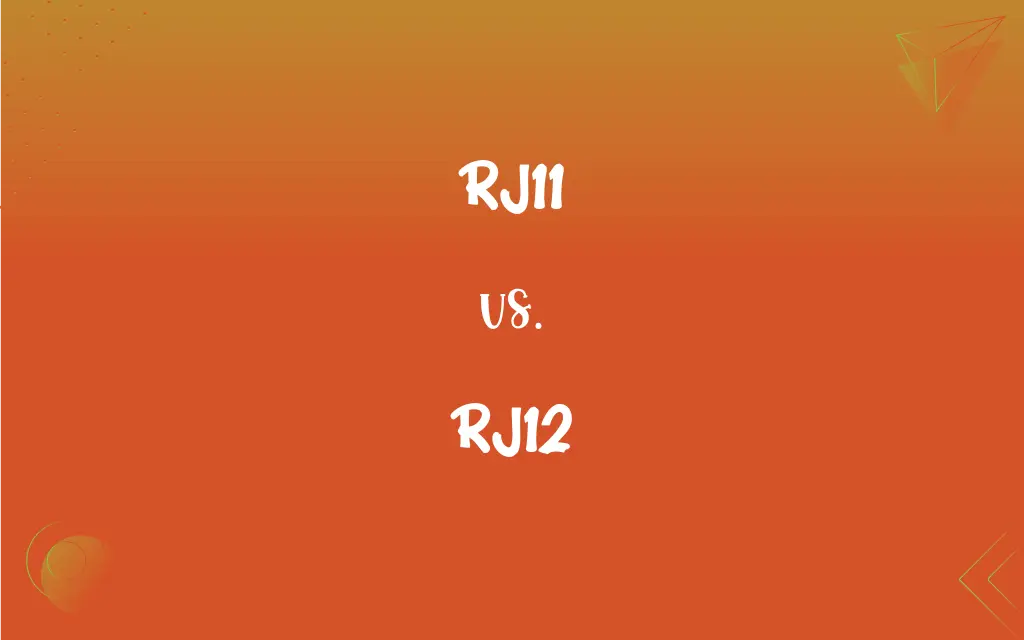RJ11 vs. RJ12: What's the Difference?
Edited by Aimie Carlson || By Harlon Moss || Published on February 15, 2024
RJ11 is a 6-position 4-conductor (6P4C) connector, commonly used for telephone lines, while RJ12 is a 6-position 6-conductor (6P6C) connector, used for various telecommunication interfaces.

Key Differences
RJ11 connectors are widely recognized in telecommunications, specifically designed for single telephone line connections using four conductors. RJ12, on the other hand, uses all six conductors, making it suitable for systems requiring more complex wiring, like certain telephone systems or data interfaces.
In terms of physical appearance, both RJ11 and RJ12 are similar, featuring a six-position plug and jack. However, RJ11 typically utilizes the middle four positions, while RJ12 uses all six, offering greater versatility for multiple signal lines.
RJ11 is predominantly used in residential telephone wiring and simple office setups, connecting a single phone line to the wall jack. Conversely, RJ12 is employed in more diverse applications, including certain types of data transmission and communication systems that require multiple lines.
The RJ11 connector is known for its simplicity and reliability in connecting standard telephones. In contrast, RJ12, with its additional conductors, is adept at handling more complex communication setups, including some types of digital data transfers.
RJ11 is a staple in basic telephony, its limited conductor usage restricts its application to single-line connections. RJ12, with its capacity to use all six conductors, caters to a broader range of telecommunication needs, including multiline phone systems and certain network interfaces.
ADVERTISEMENT
Comparison Chart
Conductor Use
4 conductors (6P4C)
6 conductors (6P6C)
Primary Use
Single telephone line connections
Multiple line telecommunication and data interfaces
Physical Appearance
6-position plug, using middle four
6-position plug, using all six positions
Application
Residential telephones, simple office phones
Complex phone systems, certain data transfers
Flexibility
Limited to single-line connections
Suitable for multiline and complex systems
ADVERTISEMENT
RJ11 and RJ12 Definitions
RJ11
A connector using four out of six available positions.
The fax machine required an RJ11 cable to connect to the telephone line.
RJ12
A connector used for multiline telecommunication and data interfaces.
The office phone system was wired with RJ12 connectors to handle multiple lines.
RJ11
A common connector in residential phone setups.
To fix the phone line, the technician replaced the old RJ11 jack.
RJ12
A 6-position 6-conductor (6P6C) interface.
For the complex telecom setup, we needed RJ12 cables, not RJ11.
RJ11
A standard interface for basic telephony.
Most analog telephone handsets are equipped with RJ11 plugs.
RJ12
A versatile connector for various communication systems.
The RJ12 jacks were installed to support the new digital communication equipment.
RJ11
A 6P4C telecommunication connector.
The RJ11 port on the modem was used to establish a dial-up internet connection.
RJ12
A six-conductor plug, offering more wiring options than RJ11.
To connect the multiline telephone system, RJ12 cables were necessary for the additional lines.
RJ11
A connector for single-line telephone connections.
The home phone was connected to the wall jack using an RJ11 cable.
RJ12
A connector suitable for certain types of network interfaces.
The control panel required RJ12 connectors for proper network communication.
FAQs
What is RJ11 used for?
RJ11 is primarily used for single-line telephone connections.
Can RJ11 and RJ12 connectors be physically interchanged?
Yes, they are physically similar and often interchangeable, but their wiring may differ.
What is RJ12 used for?
RJ12 is used for multiline telecommunication systems and certain data interfaces.
How many conductors does an RJ12 have?
RJ12 uses all 6 conductors.
Is RJ11 suitable for digital data transfer?
RJ11 is limited and not typically used for digital data transfer.
Are RJ11 connectors common in homes?
Yes, RJ11 is very common in residential telephone setups.
What does 6P4C mean for RJ11?
It means 6 position, 4 conductor – the format of the RJ11 connector.
Can RJ12 be used for standard telephones?
Yes, RJ12 can be used, but it's often more than what is needed for standard phones.
How many conductors does an RJ11 have?
RJ11 typically uses 4 conductors.
What does 6P6C mean for RJ12?
It means 6 position, 6 conductor – the format of the RJ12 connector.
Can I use an RJ11 cable in an RJ12 socket?
Yes, but the functionality might be limited based on the wiring.
Is RJ12 suitable for advanced networking needs?
RJ12 can handle more complex networking setups but is not typical for high-speed internet networking, where Ethernet cables are preferred.
Do RJ12 connectors offer more flexibility?
Yes, RJ12 offers more flexibility for complex systems due to more conductors.
Is RJ12 used in residential settings?
It's less common in residential settings and more common in business environments.
Do RJ11 cables support modem connections?
Yes, RJ11 cables are commonly used for connecting modems for dial-up internet.
Can RJ11 be used for fax machines?
Yes, RJ11 is commonly used to connect fax machines to telephone lines.
Can RJ11 be used for internet connections?
It can be used for dial-up internet connections but is not suitable for broadband.
Is RJ12 compatible with all telephones?
While it can physically fit, RJ12 might not be necessary for all telephones, especially single-line ones.
Are RJ12 cables more expensive than RJ11?
Generally, RJ12 cables might be slightly more expensive due to their additional wiring.
Are RJ11 and RJ12 the same size?
Yes, they are the same size, but the wiring configuration differs.
About Author
Written by
Harlon MossHarlon is a seasoned quality moderator and accomplished content writer for Difference Wiki. An alumnus of the prestigious University of California, he earned his degree in Computer Science. Leveraging his academic background, Harlon brings a meticulous and informed perspective to his work, ensuring content accuracy and excellence.
Edited by
Aimie CarlsonAimie Carlson, holding a master's degree in English literature, is a fervent English language enthusiast. She lends her writing talents to Difference Wiki, a prominent website that specializes in comparisons, offering readers insightful analyses that both captivate and inform.







































































